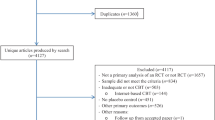Abstract
Premenstrual dysphoric disorder (PMDD), a severe type of premenstrual syndrome (PMS), is characterized mainly by psychological symptoms confined to the premenstrual period, which reduce not only patients’ quality of life, but also their working activities. Although various therapies have been employed for PMDD, some patients do not respond to them. We recently employed acupuncture treatment for a patient in PMDD. Symptoms ameliorated during the acupuncture (+) period, but deteriorated during the acupuncture (−) period. This review describes the clinical course of this case. The diagnosis and treatment of PMDD are briefly summarized and previous acupuncture treatment for PMS are reviewed. The difficulties in evaluating the effectiveness of acupuncture for PMS/PMDD are addressed. It is suggested that acupuncture may be a treatment option for PMDD.


Similar content being viewed by others
References
Pearlstein T, Steiner M (2008) Premenstrual dysphoric disorder: burden of illness and treatment update. J Psychiatry Neurosci 33:291–301
Author not specified (1994) DSM-IV: Diagnostic and statistical manual of mental disorders, 4th edn. American Psychiatric Association, Washington DC, pp 715–718
Dimmock PW, Wyatt KM, Jones PW et al (2000) Efficacy of selective serotonin-reuptake inhibitors in premenstrual syndrome: a systematic review. Lancet 356:1131–1136. doi:10.1016/S0140-6736(00)02754-9
Steiner M, Steinberg S, Steward D et al (1995) Fluoxetine in the treatment of premenstrual dysphoria: Canadian Fluoxetine/Premenstrual Dysphoria Collaborative Study Group. N Engl J Med 332:1529–1534. doi:10.1056/NEJM199506083322301
Haldreich U (2008) Selective serotonin-reuptake inhibitors and initial oral contraceptives for the treatment of PMDD: effective but not enough. CNS Spectr 13:566–572
Borenstein JE, Dean BB, Endicott J et al (2003) Health and economic impact of the premenstrual syndrome. J Reprod Med 48:515–524
White A (2003) A review of controlled trials of acupuncture for women’s reproductive health-care. J Fam Plann Reprod Health Care 29:233–236. doi:10.1783/147118903101197863
Habek D, Habek JC, Barbir A (2002) Using acupuncture to treat premenstrual syndrome. Arch Gynecol Obstet 267:23–26. doi:10.1007/s00404-001-0270-7
Kim SC, Moon HC, Kim SN et al (2006) Effect of acupuncture treatment on the premenstrual syndrome: controlled clinical trial. J Jap Soc Acupunct Moxibust 56:135–138 in Japanese with English abstract
Stener-Victorin E, Waldenstrom U, Tagnfors U et al (2000) Effects of electro-acupuncture on anovulation in women with polycystic ovary syndrome. Acta Obstet Gynecol Scand 79:180–188. doi:10.1034/j.1600-0412.2000.079003180.x
Moos RH (1968) The development of a menstrual distress questionnaire. Psychosom Med 30:853–867
Bailey JW, Cohen LS (1999) Prevalence of mood and anxiety disorders in women who seek treatment for premenstrual syndrome. J Womens Health Gend Based Med 8:1181–1184
Casper RF, Yonkers KA (2006) Clinical manifestation and diagnosis of premenstrual syndrome and premenstrual dysphoric disorder. Up to date version 16.3 (accessed on 26 February 2009)
Yonkers KA, Brown C, Pearlstein TB et al (2005) Efficacy of a new low-dose oral contraceptive with drospirenone in premenstrual dysphoric disorder. Obstet Gynecol 106:492–501
Berger CP, Presser B (1994) Alprazolam in the treatment of two subsamples of patients with late luteal phase dysphoric disorder: a double-blind, placebo-controlled crossover study. Obstet Gynecol 84:379–385
Han JS, Trenius L (1982) Neurochemical basis of acupuncture analgesia. Annu Rev Pharmacol Toxicol 22:193–220. doi:10.1146/annurev.pa.22.040182.001205
Griffin LD, Mellon SH (1999) Selective serotonin reuptake inhibitors directly alter activity of neurosteroidogenic enzymes. Proc Natl Acad Sci USA 96:13512–13517. doi:10.1073/pnas.96.23.13512
White A, Hayhoe S, Hart A et al (2001) Adverse events following acupuncture: prospective survey of 32,000 consultations with doctors and physiotherapists. BMJ 323:485–486. doi:10.1136/bmj.323.7311.485
Author information
Authors and Affiliations
Corresponding author
Rights and permissions
About this article
Cite this article
Taguchi, R., Matsubara, S., Yoshimoto, S. et al. Acupuncture for premenstrual dysphoric disorder. Arch Gynecol Obstet 280, 877–881 (2009). https://doi.org/10.1007/s00404-009-1034-z
Received:
Accepted:
Published:
Issue Date:
DOI: https://doi.org/10.1007/s00404-009-1034-z




